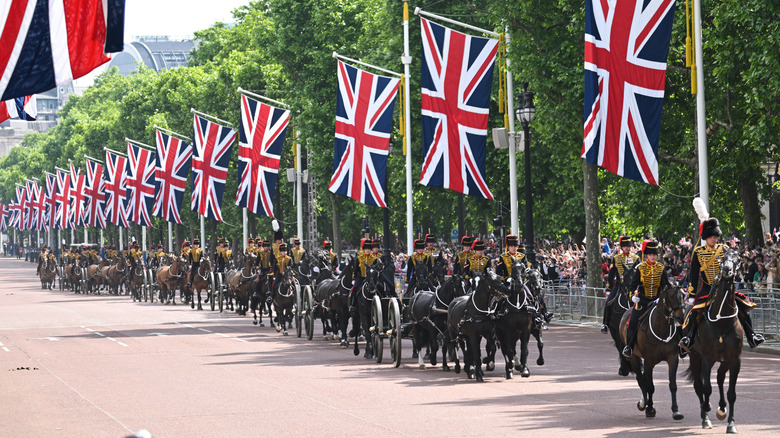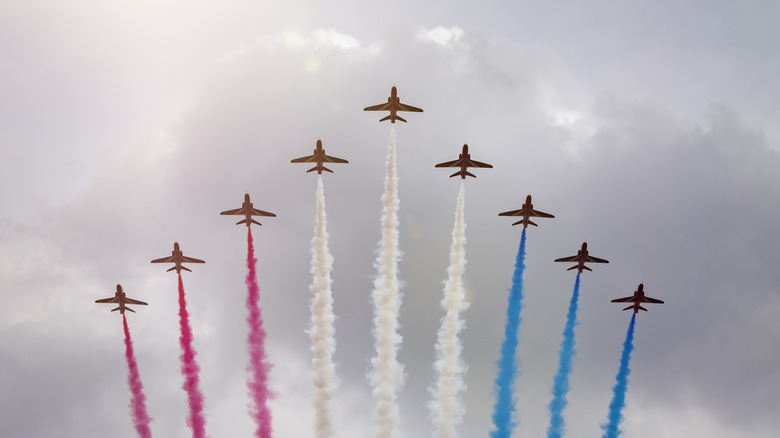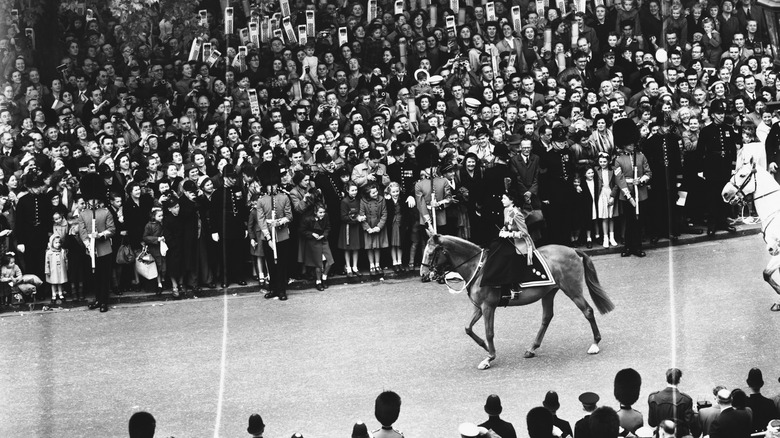What Is The British Trooping Of The Colour?
The British do enjoy their lavish ceremonies and theatricality, a healthy service of both pomp and circumstance — both the Edward Elgar music and the general concept of pageantry — which has also proven to be a major draw for tourists. Visitors to Britain are often keen to take in the much-ballyhooed Changing of the Guard. This ceremony sees one group of Old Guard soldiers join with another (from Buckingham Palace and St James' Palace, respectively) at Buckingham Palace. The New Guard arrive from Wellington Barracks, and as their names suggest, the Old are replaced at their station by the New. Of course, this could all take place subtly and practically, with little to no fanfare, but the traditional process continues today and takes almost an hour of elaborate movement and posturing to complete. It's quite a thing to behold, and dates back to the mid-17th century, continuing as official royal residences changed.
The Trooping of the Colour is another British military to-do, and an even more significant and spectacular display of British royal pageantry which takes pride of place in the yearly royal calendar each June. which adds to its spectator appeal.
Saluting the King's birthday in style
The Trooping of the Colour is essentially an elaborate military parade to mark the official birthday of the British monarch. The official birthday is a separate occasion from the monarch's actual birthday: King Charles III was actually born on November 14, 1948.
To honor this illustrious occasion more than 1,400 soldiers take part in the parade, not to mention several hundred horses and military band members, as well as jets from the Royal Air Force. Though the soldiers involved wear their eye-catching traditional bright-red uniforms, they are absolutely the real thing: each of them is in active service. The great procession travels down the iconic stretch of The Mall from Buckingham Palace, watched by admirers from around the world, various members of the royal family and, naturally, the King and Queen Consort.
And the name? To "troop the colour" is to pass a sort of standard of a given regiment between a line of soldiers of the said regiment. There are five Household Regiments (Irish Guards, Scots Guards, and Welsh Guards, plus the Coldstream and Grenadier regiments), and a different regiment troops their color each time this extraordinary parade occurs.
A long, noble tradition
The Trooping of the Colour is an annual event that dates back much further than King Charles III or his long-reigning mother, Elizabeth II. It is a tradition that has its roots in the 17th century, a period when the close-quarters chaos of battle meant that an army's regiments carried identifying standards, or colors (or in England, colors), so that everybody knew where the heck everybody was.
The tradition as we know it today is a more elaborate version of the daily parades during the time of King George III (who reigned from 1760 until his death in 1820) and even earlier. It was George who was the first monarch to have his birthday celebrated in such a theatrical fashion.
And all these years later the tradition continues annually. The parade follows the route to Horse Guard's Parade, returning to Buckingham Palace and culminating in an RAF formation flying overhead. Queen Elizabeth II has attended the Trooping of the Colour every single year since her coronation — even when the event was stripped down as a result of the COVID-19 pandemic — except for one: In 1955, the Trooping of the Colour was canceled because of a train strike.


